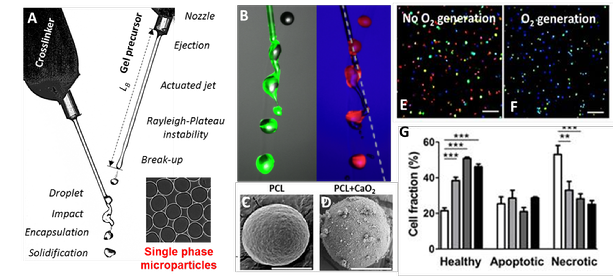Ultra-high throughput production of oxygen generating micromaterials
Oxygen is essential to nearly all forms of life. Every single one of our cells requires oxygen to survive and function. However, implanted engineered tissues are not vascularized and thus eventually fail due to lack of oxygen. We recently have designed microparticles that allow for controlled generation of oxygen, which could efficiently bridge the prevascular phase of implanted engineered tissue. Although it has been possible to fabricate these particles in small, academically relevant quantities, a radically new and technological advanced approach is required to increase the production to clinically relevant quantities.
In this project we will use a novel technique to achieve ultra-high throughput production of oxygen generating micromaterials. Specifically, we will explore in-air-microfluidics to fabricate these microparticles. The goal of this project is to achieve ~50 kHz production rates, and to evaluate the function of the microparticles. This will achieved by quantitating the oxygen release profile of the microparticles. Moreover, the ability of these particles to maintain cell survival under anoxic (no oxygen) conditions will be evaluated using mesenchymal stem cells.
Specifically, you will be involved in the optimizing of the in-air-microfluidic production of microparticles, examining their oxygen release, and determining their ability to maintain cell survival using biochemical and immunohistochemical techniques. This project will therefore provide aspiring students with an interdisciplinary skillset and knowledge framework on microfabrication, microfluidics, biomaterials, tissue engineering, and stem cells.

Figure 1: (A) In-air-microfluidics set-up for the ultra-high production of microparticles, (B) which amongst other relies on controlled in-air collision of liquids. Anticipated Scanning Electron Microscopy images of microparticles (C) non-laden and (D) laden with oxygen generating molecules. (E-G) It is expected that these particles will minimize the amount of cell death caused by lack of oxygen.
